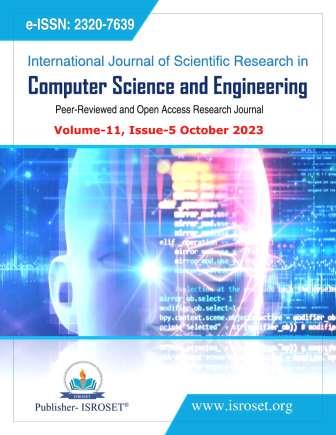Integrated Management of Patient Health Records with Smart Card and Its Benefits
Keywords:
Patient, Integrated, Smart card, patient health record (PHR), RFID, OTP, Cloud, Electronic Health Record (EHR), Accessibility, Security, Cloud storageAbstract
The healthcare system is facing critical issues with the effective and efficient storage and retention of patient health records. As information technology is gradually becoming more important nowadays, its use in health records has become crucial. The challenge of present documentation in electronic health records (EHRs) is that there is not enough documentation to demonstrate the quality and necessity of care. Common errors in using the EHRs were found to be more like scattered and discrete data without integration, which ultimately were not usable. Smart cards may be utilized for integrated health records and to simplify the prescription process, facilitate the delivery of care, and improve the standard of care given. Smart cards are portable integrated devices with data storage and data processing capabilities. The research paper focuses on how smart card technology can be applied to an essential and vital sector of healthcare. The system uses smartcards for personal identification and transfer of health data and provides data communication. In addition to personal information, general health information about the patient is also loaded onto the patient’s smart card. Healthcare providers use smart cards to access data about patients. Electronic health records with smart card usage enhance the integrated approach and have several advantages over paper records such as improving the accuracy, and quality of patient care, and reducing cost, efficiency, and productivity.
References
Manisha Wadhwa “Electronic Health Records in India”, ICT India Working Paper #25 CSD Working Paper Series, pp.1-23, March 2020.
Attahiru Saminu, “A Paradigm for Efficient Security of Information System Control in Healthcare Organizations in Nigeria”, International Journal of Scientific Research in Multidisciplinary Studies Vol.9, Issue.5, pp.14-21, May 2023.
Farida Attar , Amina Bhatkar, S Hasan Haider , Tahir Abbas Kadiwala, “RFID Based Universal Transaction System”, International Journal of Scientific Research in Computer Science and Engineering Vol.8, Issue.2, pp.52-54, April-2020.
Carey DJ, Fetterolf SN, Davis FD, Faucett WA, Kirchner HL, Mirshahi U, Murray MF, Smelser DT, Gerhard GS, Ledbetter DH., “The Geisinger MyCode community health initiative: an electronic health record-linked biobank for precision medicine research.” Genet Med. pp.18(9):906-3, Sep-2016.
Kiah ML, Zaidan BB, Zaidan AA, Nabi M, Ibraheem R. , “MIRASS: medical informatics research activity support system using information mashup network Journal of Medical Systems Volume 38 Issue 4, pp.1–15, April 2014.
Alanazi HO, Zaidan AA, Zaidan BB, Kiah ML, Al-Bakri SH. “Meeting the security requirements of electronic medical records in the ERA of high-speed computing.” J Med Syst.pp.39(1):165, Jan-2015. [7] Ismail Keshta, Ammar Odeh, “Security and privacy of electronic health records: Concerns and challenges”, Egyptian Informatics Journal, Volume 22, Issue 2, pp. 177-183, ISSN 1110-8665,2021.
Jannetti MC. (2014), “Safeguarding patient information in electronic health records.” AORN Journal;100(3): pp. C7–C8, 2014.
Bouayad L, Ialynytchev A, Padmanabhan B. “Patient Health Record Systems Scope and Functionalities: Literature Review and Future Directions.” J Med Internet Res. 15; pp. 19(11): e388, Nov-2017.
Bodake, A., Baviskar, V., Bodake, A., Bhoite, S., and Kulkarni, N. J. (2012), “Multipurpose Smartcard System.”, International Journal of Advanced Research in Computer Engineering & Technology (IJARCET), 1(9).pp. 175-178, 2012.
Martha E. Haykin Robert B. J. Warnar, “Smart Card Technology: New Methods for Computer Access Control”, Computer Science and Technology; NIST Special Publication pp.500-157, 1988.
Singh, A., Chopra, A., Imran, M., and Singh, R. (2017), “Designing and Implementation of Smart Card Technology for the Students of Higher Education.”, International Journal of Computer Science and Mobile Computing IJCSMC, 6, pp. 144-149.,2017.
Taylor DN. “A literature review of electronic health records in chiropractic practice: common challenges and solutions.” J Chiropr Humanit 1;24(1): pp.31–40, Dec-2017.
Bouayad L, Ialynytchev A, Padmanabhan B. “Patient Health Record Systems Scope and Functionalities: Literature Review and Future Directions.” J Med Internet Res. 15; pp.19(11): e388, Nov-2017.
Pelletier, M.-P., Trépanier, M. & Morency, C. (2011). “Smart card data use in public transit: A literature review.” Transportation Research Part C: Emerging Technologies, 19, pp.557—568, 2011.
Ayan Patel, Kansara P., Marvania M., Shah A. (2019), “Patient Smart Card”; IJSART -Volume5 Issue1, pp.5-7, January-2019.
K. W. Ashan Pivithuru, A. Srinivasan, A. Wijeratnam, I. Nassar, S. S. Chandrasiri and P. K. Suriyaa Kumari, "E-patient Card: An Integrated Electronic Health Recording System for Patient," 2021 3rd International Conference on Advancements in Computing (ICAC), Colombo, Sri Lanka, pp.395-400, 2021.
Downloads
Published
How to Cite
Issue
Section
License

This work is licensed under a Creative Commons Attribution 4.0 International License.
Authors contributing to this journal agree to publish their articles under the Creative Commons Attribution 4.0 International License, allowing third parties to share their work (copy, distribute, transmit) and to adapt it, under the condition that the authors are given credit and that in the event of reuse or distribution, the terms of this license are made clear.







